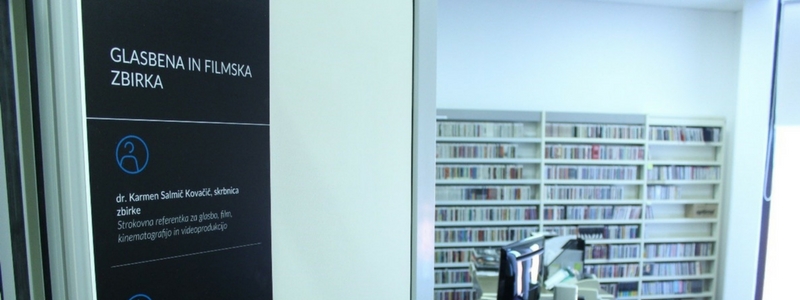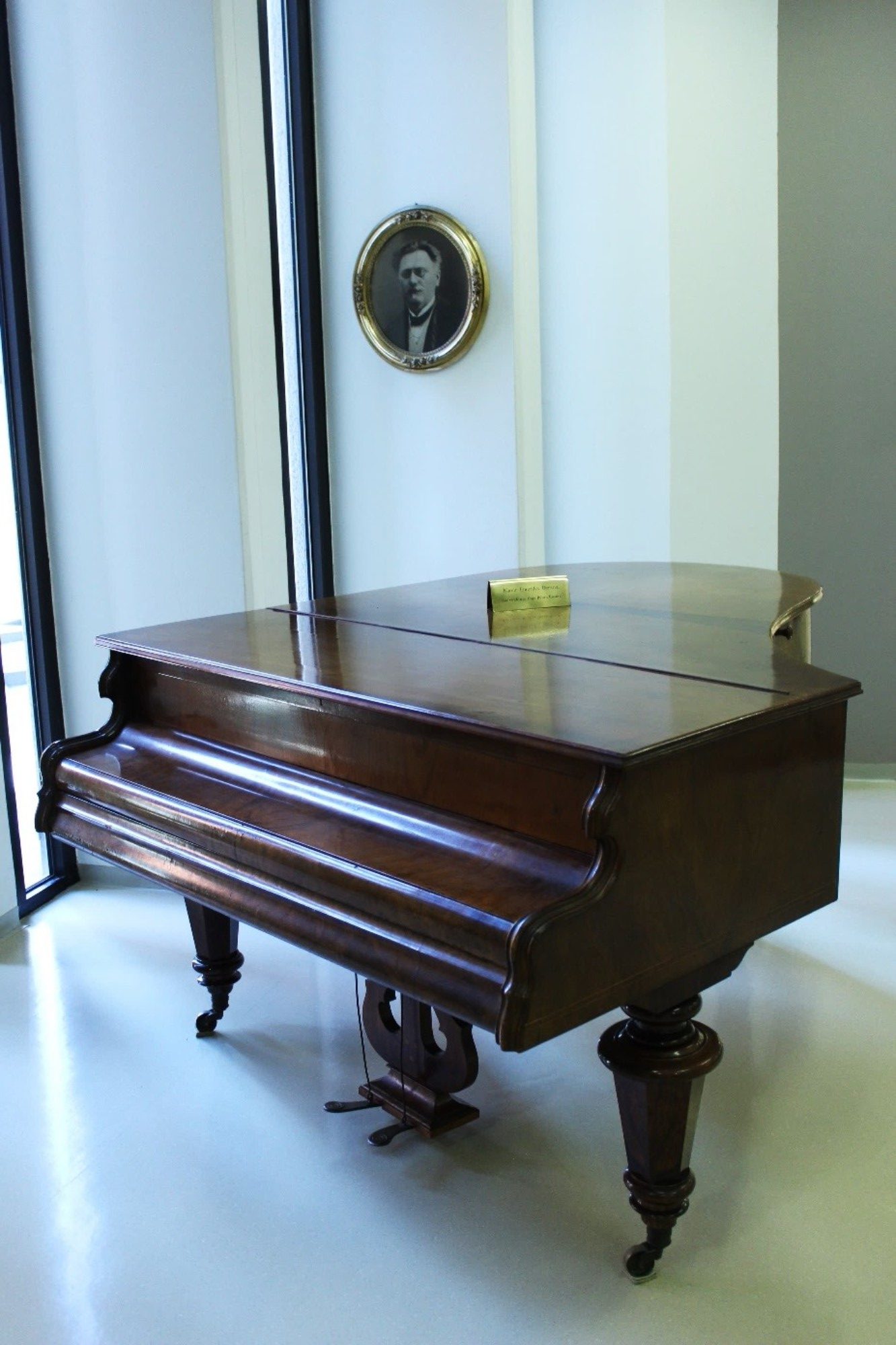With around 60,000 items, the Music and Film Collection of University Library Maribor (ULM) is the largest collection of its kind in north-east Slovenia. Apart from the Music Collection of the National and University Library in Ljubljana, it is the only deposit library in Slovenia to compile a compulsory copy of, and permanently archive, the entire Slovenian production of audio and video recordings – the most extensive part of the collection apart from music publications and printed sheet music that constitute the first and oldest part of the collection’s holdings. The collection’s accumulated material not only supports scholarly or scientific research, but also plays a wider cultural and artistic role: it is a platform generating a flow of ideas and spreading information, facilitating cultural and artistic enrichment and the interaction of artists. Moreover, as a valuable and rich source of recent and older sheet music, music manuscripts, music and video recordings in different media, including gramophone records, audio cassettes, CDs, video cassettes, video DVDs and Blu-ray disks, the collection is an important resource for teachers, choirmasters, researchers and various artists working in filmmaking or professional and non-professional musicians.
Users of the music and film collection have access to the legacy of composers and other musicians from Maribor and its environs, as well as audio and video recordings from private archives or from the archives of RTV Slovenia, including documentary films about notable institutions, phenomena and artists who worked in north-east Slovenia.
The collection operates principally as a reference library and, in general, materials may not be removed from the reading room. By arrangement and under special conditions, a small part of the collection is available for scholarly or scientific research (e.g. legacies, manuscripts, archival footage, etc.), and some of the collection is available for lending.
Music and Film Reading Room
The latest addition to the collection and the library, the Music and Film Reading Room was established in 2014. It also contains some freely accessible non-book library materials, including the appertaining technical equipment that supports the playing of audio-visual and audio recordings in all audio-visual formats. The Clavinova was donated by the Friends of ULM Club. Users of the reading room can thus practise the piano, which also serves them in composing music, or watch films, listen to music, examine library materials or study, as the reading room headphones enable patrons to engage in different activities at the same time without disturbing others. Sheet music has been arranged by content indexing, according to the universal decimal classification (UDK), while DVDs storing fictional features and documentary films and CDs containing music have been classified alphabetically in line with the system of letter-word association of cinematic genres, periods or music genres. In the reading room, musicians can find comprehensive collections of choral music, favourite popular songs, piano pieces or, for example, manuals for learning the guitar. Patrons can watch films in the reading room, selecting from documentary films about composers or Academy Award winning feature films with fictional subjects, browse through the latest offering of CDs of choral music or listen to twentieth-century or Renaissance music. CDs are shelved according to historical periods, ranging from Antiquity to the twenty-first century, according to music genres from folk music to world music, ranging from religious, meditational and film music to jazz, rock, blues, country, chanson and pop-folk music. Classical music is further classified into instrumental, vocal and vocal-instrumental music. The room features an attractive interior design and provides a suitable venue for relaxation, an occasional public talk or simply socialising.
Highlights of the Music Collection
In keeping with tradition, the local studies materials housed at the Maribor University Library have been instrumental in research about Maribor’s cultural history. The materials are compiled and kept by the Department of Regional Studies, and a special collection consisting of small publications, photographs, postcards, maps, manuscripts, old periodicals, rarities, music-score manuscripts, printed matter, and audio and video recordings. It is with special attention that the Music and Film Collection also acquires and keeps artworks, documentary materials or complete legacies of composers and other musicians or filmmakers. Some of the most valuable examples are the legacies of composer Emerik Beran, the opera singers Miloš Brišnik and Dragica Sadnik, the director’s scripts of opera director Franjo Potočnik, part of the sheet-music legacy and the bulk of the book bequest of choral conductor Branko Rajšter, MA, and the complete set of works by composer Zlatan Vauda.
Exhibitions, Publications and Films Dealing with Music Subjects
The Library occasionally holds exhibitions and organises projects with the aim of calling attention to its music and film materials and thus fostering appreciation and awareness among the broader public. The Library’s most notable exhibitions of its music and film holdings include commemorations of the anniversaries of violinist Nada Jevdjenijević Brandl, composers Zlatan Vauda and Emerik Beran, conductor Jakov Cipci, opera singers Ondina Otta Klasinc and Ada Sardo, actor Janez Klasinc, Carmina Slovenica, pianist Dr Roman Klasinc and choirmaster Branko Rajšter, MA. Anthologies containing memoirs of their contemporaries have been dedicated to the last two named, edited by the current collection curator (Dr. Roman Klasinc (1907–1990): ob obletnici rojstva, 2007; Spomini na Rajštra, 2004; Dr Roman Klasinc (1907–1990): On the Anniversary of His Birth, 2007; Memories of Rajšter, 2004). Also, a double CD of Rajšter’s music was released, featuring renditions by various choirs under his direction.
In 2012, the year Maribor was declared European Capital of Culture; a large-scale project, including an exhibition, concert and a commemorative plaque unveiled in his native town, Pernica near Maribor, was dedicated to composer Zlatan Vauda, who settled in Belgrade after being exiled during World War II.
Held within the context of Maribor European Capital of Culture, another prominent project was Domofil(m) – lokalne filmske pripovedi (National Film – Local Cinematic Narratives), featuring screenings of 35 documentary films treating regional historical subjects and kept in the RTV Slovenia archives. The collection of documentary, narrative and docufiction films featuring eminent figures, institutions and cultural specifics of north-east Slovenia includes films addressing musical themes (Ipavci: družinska kronika, Hugo Wolf: poklican in izbran and Placebo – Carmina Slovenica; Ipavec Composers: Family Chronicle, Hugo Wolf: A Vocation and Talent, and Placebo – Carmina Slovenica), which are available for library viewing by prior arrangement.
Brief History of the Music Collection
Forming the core of the music collection, sheet-music materials were gradually separated from other library holdings. The first classification of music requisites – sheet music, music scores and songbooks – was processed in 1947, and since 1957 records have been kept in a separate inventory ledger. Until then, from its early stages within the context of The Historical Society of Lower Styria (1903), the materials of the present-day music and film collection formed part of the common library holdings.
The music collection was compiled more independently, to some extent, from the late 1970s, but was designated its own room and assigned a qualified professional to act as a special editor or curator as late as in 1993. The first gramophone records were added to the sheet-music materials, scores and songbooks in 1962, audio cassettes in the 1970s and CDs in the 1980s. Today, the music holdings include around 35,000 items, of which approximately 20,000 are music audio recordings and around 15,000 scores and sheet-music materials. The history of more recent audio-visual recordings kept in the Maribor University Library goes back to the late 1980s, when the collection expanded to include videos on videocassettes and subsequently on DVDs in Blu-ray discs. Today, the collection contains over 25,000 items of this kind. The audio-visual materials were jointly titled the Music and Film Collection in 1995.
In its early stages, the music collection was curated by Ivanka Baran-Žmavc, Vasja Sterlè and Majda Špes, who bibliographically processed, inventoried and partially edited the materials. From 1993, Dr Mitja Reichenberg was the first librarian assigned to exclusively curate the music and film collection, as its editor and the first appointed qualified professional for both audio and visual materials. Reichenberg designated a special room for the collection on the third floor of the library, and was occasionally assisted in curating and processing the materials by Andreja Kaučič Vajngerl. In 1997, Reichenberg was succeeded by the current curator, Dr Karmen Salmič Kovačič. With a view to expanding the central premises for music and film collection processing, Salmič Kovačič had a music and film reading room set up during the renovation of the library’s third floor in 2014, enabling the first free access to this material and at the same time providing for its reproduction.
Dr Karmen Salmič Kovačič, collection curator









